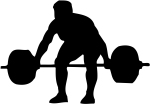- FreeTrainers.com Forums
- Strength & Powerlifting
- Rationalizing
Group: Strength & Powerlifting
Created: 2012/01/01,
Members: 38,
Messages: 16459
Discuss the topic of Power lifting, Strength training and Strong Man training!
Join group
Rationalizing

Tinnuk
Posts:
291
Joined: 2005/12/19  |
2008/02/12, 01:10 PM
Re-reading something again that pretty much contradicts everything I've learned, including from this site, I'm seeing how well I can rationalize my disagreement through what I've learned elsewhere. One of the things he talks about is coordination being non-transferable; that something like intermuscular coordination developped from weight training won't carry over into other activities. Apparently imitating movements in sport under more difficult conditions (such as sprinting with a parachute), will not improve performance, and can, in fact, develop new memory patterns which can interfere with the original.
|
|
| |

rev8ball
Posts:
3,081
Joined: 2001/12/27  |
2008/02/12, 02:04 PM
Who is "he?"-------------- Michael Strength & Conditioning is not everything; it just really sucks to be weak and slow. |

Tinnuk
Posts:
291
Joined: 2005/12/19  |
2008/02/12, 02:10 PM
Right, right...He's the author of of a book called "Full Strength", Werner Keiser; should've mentioned that earlier.
|

wrestler125
Posts:
4,619
Joined: 2004/01/27  |
2008/02/12, 02:12 PM
I agree.
You can't develop new coordination patterns and expect them to carryover. Standing on a bosu ball will make you better at standing on a bosu ball, it won't improve your balance. And for track athletes with good form, running in non-optimal conditions may cause changes in form through compensation. HOWEVER... If you can better utilize a muscle in an exercise like squatting, then you can better use it when sprinting or jumping. Weight lifting was never meant to carry over in terms of coordination. It was meant to make you stronger, which will allow you to do the patterns you already know faster and more explosively. Anyone that disagrees with this can continue being weak and taking second place. Also, I'm not sure if the use of the term "intermuscular coordination". I've learned intermuscular to be the stuff in between muscle (ie fascia, septum, etc.) -------------- SQUAT MORE ~Jesse Marunde Blood Guts Sweat Chalk |

Tinnuk
Posts:
291
Joined: 2005/12/19  |
2008/02/12, 02:17 PM
I see; with that then, why is it that isolation exercises are inferior to compound exercises (isolation exercises are something that he advocates, as well as machine based training)? I though that isolatory resistance training was inferior due to the fact that it didn't promote intermuscular coordination.
"Inter" generally refers to within a group, whereas "intra" would be within a single thing. |

wrestler125
Posts:
4,619
Joined: 2004/01/27  |
2008/02/12, 02:28 PM
Good question. Disregarding the roles of stabilizers, more muscle being used, more CNS activation...
That may be a different kind of coordination. When I said "better utilize a muscle" this is exactly what I meant. You are using the muscles together as a whole, and getting better at it. However, the coordination developed in sports is different, in my opinion. I'm not sure what the movement rate is for sprinting, but I know it's damn fast. You are using muscles alternatively at a very high firing rate, and all at the same time (vs the strain and limited coordination of squatting). Firing rates are very different. I've even heard that the best sprinters aren't always the ones that can fire their legs the fastest, but also have to be the ones that can RELAX the right muscles at the right times. This is a very specific task. I'd love to train athletes to compete against a guy that thought the leg curl would be better for speed development than full squats. I think you'd get some good ideas from the russian model of mastery for sports. Their youngins are started out doing gymnastics, wrestling, tumbling drills, soccer, etc to develop coordination. However, as they age, this ability to develop coordination, balance, etc gradually dimishes, and they choose the sport they will compete in. As for terms... Merriam-Webster's Medical Dictionary - Cite This Source - Share This Main Entry: in·ter·mus·cu·lar Pronunciation: -'m&s-ky&-l&r Function: adjective : lying between and separating muscles <intermuscular fat> Merriam-Webster's Medical Dictionary, © 2002 Merriam-Webster, Inc. Webster's Revised Unabridged Dictionary - Cite This Source - Share This Intermuscular \In`ter*mus"cu*lar\, a. (Anat.) Between muscles; as, intermuscular septa. -------------- SQUAT MORE ~Jesse Marunde Blood Guts Sweat Chalk |

Tinnuk
Posts:
291
Joined: 2005/12/19  |
2008/02/12, 02:40 PM
Zatsiorsky talks about intermuscular coordination in "Science and Practice of Strength Training" as being a reason for using single joint exercises only in a supplementary manner on page 63 (if you have the second edition). I suppose the first place I came across the term would be in "Power to the People" when Pavel denounces isolation exercises.
I really think the people who come up with the terms really like to jerk people around; they seem to change either over time or from area to area... "Intra" and "Inter", with the definitions I gave you, were used in the context of chemistry to describe bonding within molecules (intra) and within groups of molecules (inter). |

Tinnuk
Posts:
291
Joined: 2005/12/19  |
2008/02/12, 02:42 PM
Perhaps there's a better word than "coordination" for the quality that is being carried over into sport...
|

merrillj
Posts:
197
Joined: 2007/06/28  |
2008/02/12, 03:36 PM
Here is the link to the website for this guy's training method: http://www.kieser-training.com/au_english/pages/HO/HO.shtml?navid=1
Check out these awesome training principles this guy uses: 1. Train once or twice a week Each training programme should cover the entire body and have a maximum of 10 exercises. Research into the science of training has shown that one or two sessions per week is enough to train most muscle groups provided that each exercise is done to local fatigue (Smith & Bruce-Low 2004). If doing strength training for health, all parts of the body must be included because the transfer effect to non-trained parts is marginal. 2. Train lower body muscles first Start by training the larger muscle groups as this quickly activates the nervous system, metabolism, hormonal circulation and cardiovascular system. Overall, this method produces a higher training stimulus. In addition, it is often easier to do exercises for the larger muscle groups correctly at the beginning of the session than at the end. 3. Select a training weight with which you can do each exercise for 60 - 90 seconds The positive phase of the exercise - lifting the weight - should take a minimum of 4 seconds. The negative phase - lowering the weight - should similarly take 4 seconds. Between the two phases, hold the complete contraction for 2 seconds. The level and duration of tension produced in the muscle are crucial to the success of strength training. If the exercise is done as slowly as possible, this increases the level of tension in the muscle and increases the strength gain (Smith & Bruce-Low 2004). 4. Avoid jerky or «explosive» movements; they are dangerous and counterproductive The faster the speed of the exercise, the less control you have over it. High levels of torque increase the risk of injury. If exercise speed is increased, this reduces the level of tension in the muscle and with it the training gain. 5. Do each exercise until the muscles involved reach local fatigue, i.e. you cannot complete another repetition If you can do the exercise for more than 90 seconds, make a note on your training card to increase the weight at your next session by about 5%. Similarly, if you are unable to manage 60 seconds, reduce the weight by 5%. The key to successful strength training is a gradual but regular increase in training weight. At each session, either try to extend the length of time before reaching muscle fatigue or increase the training weight. The final repetitions of each exercise are the most strenuous and the most important. It is when training intensity is at its highest and the maximum possible number of muscle fibres are required to work. 6. Avoid help from other parts of the body, i.e. do not turn, wriggle or swing the body Such evasive action multiplies the force on muscles and joints and increases the risk of injury. 7. Isolate the relevant muscles as much as possible That means releasing the tension in muscles not involved in the exercise. In particular, keep the muscles of the hands, neck and face relaxed. Unnecessary static muscle contractions have a detrimental effect on output because they use energy, trigger inhibitory processes in the nervous system and put a greater strain on the cardiovascular system. 8. Don't hold your breath during the exercise and do not attempt exhalation against closed air passages (valsalva manoeuvre) The rhythm of breathing does not have to coincide with the rhythm of the exercise. If effort levels are too high, breathing tends to be forced. This increases pressure in the abdominal cavity and causes major variations in blood pressure. 9. If possible, move briskly from one machine to the next for additional cardiovascular benefit Active muscle effort increases the oxygen requirement and so strength training increases the heart and respiratory rate. To keep both at an elevated rate during the entire session, keep the time between individual machines to a minimum. 10. Train each muscle to local fatigue in one set It makes no sense to do multiple sets as training stimuli are not cumulative. All well-controlled studies using the right methodology have shown that multi-set training produces no significant benefit (Smith & Bruce-Low 2004). 11. Don't increase the weight at the expense of quality Increases in weight should not result in a reduction in your personal range of motion (ROM). Nor should it result in evasive movements. Training over the entire ROM ensures that increases in muscle strength are in balance. Output is maximised as is the protection against injury. 12. Enter the weight for your next session on your training card Clear training records make it easier for you and your instructor to monitor and plan your training. 13. Before, during and after training, drink sufficient water - without additives Intensive muscle effort makes you sweat and much of this is water. Sweating, therefore, increases the concentration of electrolytes in your body. This means that it is more important to drink sufficient water during and after training than it is to add electrolytes. 14. To give your muscles time to recover allow at least 48 hours between training sessions The reduction in physical capacity after strength training is a combination of local muscle fatigue and fatigue of the central nervous system. The amount of time the body requires to regenerate can be several hours or several days; the length of time depends upon personal ability to recover and training intensity . This looks lika an exact copy of Ken Hutchins "slowburn" method. Looks like commercial gym "use machines" nonsense. |

merrillj
Posts:
197
Joined: 2007/06/28  |
2008/02/12, 03:49 PM
Correction: Ken Hutchins is the proprietor of the "Superslow" method.
|

wrestler125
Posts:
4,619
Joined: 2004/01/27  |
2008/02/12, 07:03 PM
I would suspect so, and this is kind of what I was referring to.
============ Quoting from Tinnuk: Perhaps there's a better word than "coordination" for the quality that is being carried over into sport... ============= As for SPST, I don't even need to grab my copy to know what you are referring to, since just last week I used the next page (rate coding) as a reference in a paper for class. That is why all this stuff is fresh in my head. -------------- SQUAT MORE ~Jesse Marunde Blood Guts Sweat Chalk |

wrestler125
Posts:
4,619
Joined: 2004/01/27  |
2008/02/12, 07:05 PM
Non of what he is saying is necessarily... wrong... just far from optimal for someone who shares the goals of getting stronger, faster, or becoming a better athlete.-------------- SQUAT MORE ~Jesse Marunde Blood Guts Sweat Chalk |

Tinnuk
Posts:
291
Joined: 2005/12/19  |
2008/02/12, 07:46 PM
In his book "Full Strength" he expands alot on alot of these principles; what bugs me is that (and I could be wrong) he seems to express these with an almost arrogant tone, which comes across as very obnoxious, especially considering that most of it is bs (or at least close to it).
For instance; he claims that isolation is necessary to reach the stimulus threshold. Apparently in compound movements, extra, working muscles will become fatigued, but won't reach the stimulus threshold themselves. My question is, how the hell could they become fatigued if they're not even involved enough to be in the stimulation zone? Perhaps with the set and overall volume in his routines this would be possible, but it still doesn't seem logical to me. |
